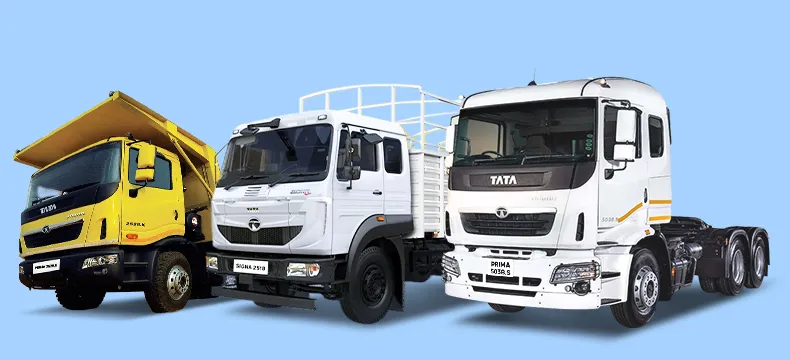9 Sep 2025

How does improper weight distribution affect your truck?
- Tata Motors
- 29 Nov 2024
- COMMERCIAL VEHICLE
Introduction
Proper truck weight distribution is crucial for safe and efficient driving. Imbalanced loads can cause instability, increase wear and tear, and pose safety risks on the road. In this blog, we'll explore the importance of truck weight distribution, how it affects your vehicle, and best practices for checking and maintaining it. We'll also touch on truck axle weight limits, payload distribution tips, and effective load-balancing techniques to keep your truck performing at its best.
Weight Distribution in Trucks
Truck weight distribution refers to how the weight of the load is spread across the vehicle. Proper weight distribution is vital for maintaining stability, optimising performance, and ensuring safety on the road. Imbalanced loads can lead to increased fuel consumption, excessive tyre wear, and heightened risks of accidents. Here's a closer look at why weight distribution in trucks is so important and how it affects your vehicle:
-
Impact on Vehicle Stability and Handling
- Proper truck weight distribution ensures that the vehicle remains stable, especially during turns and on uneven surfaces. If the load is too heavy on one side or placed too far back, it can cause the truck to sway or even tip over.
- Poor weight distribution can also affect steering and braking, making the truck harder to control. This is particularly dangerous in emergency situations where precise handling is crucial.
-
Effects on Axle Loads
- Trucks are designed with specific truck axle weight limits, and exceeding these limits can cause significant damage to the vehicle. Overloaded axles can lead to broken suspensions, bent axles, and even structural damage to the truck's frame.
- Uneven weight distribution can also cause individual axles to bear more weight than they are designed for, increasing the risk of mechanical failure.
-
Fuel Efficiency and Tyre Wear
- Proper weight distribution in trucks contributes to better fuel efficiency. An imbalanced load creates additional drag and forces the engine to work harder, increasing fuel consumption.
- Uneven weight distribution also leads to irregular tyre wear, reducing the lifespan of your tyres and increasing operational costs. Ensuring even load distribution helps maintain optimal tyre contact with the road, reducing wear and tear.
-
Safety Risks and Legal Implications
- Improper truck weight distribution not only compromises safety but also violates regulations. Overloading and poor weight distribution can result in fines and penalties, especially if the truck fails roadside inspections.
- Ensuring your truck complies with legal truck axle weight limits is essential for avoiding legal issues and keeping the roads safe for everyone.
How to Check Weight Distribution in Trucks
Maintaining proper weight distribution in trucks involves regular checks and adjustments to balance the load. Here are some practical tips on how to check weight distribution in trucks:
-
Use Onboard Weighing Systems
-
Manual Weighing at Scales
-
Visual Inspection and Measurement
-
Payload Distribution Tips and Load Balancing Techniques
Top Tata Motors Trucks in Tanzania
Tata Motors is a leader in the commercial vehicle industry and is known for producing trucks that excel in performance and load management. Proper truck weight distribution is a critical aspect of vehicle design, directly impacting the truck's stability, fuel efficiency, and safety on the road.
Let's take a detailed look at how specific Tata truck models support effective weight distribution and why they are ideal choices for demanding trucking needs:
Tata Signa 2518.T
The Tata Signa 2518.T is a robust heavy cargo truck with a Cummins B5.9 engine, which delivers 180 HP and a peak torque of 690 Nm. This truck is designed with a strong load body and high-quality aggregates that are essential for maintaining proper truck weight distribution:
-
Strong Load Body Design
The Signa 2518.T features a body engineered to handle heavy and uneven loads without compromising stability. The truck's design ensures the weight is centred and balanced, reducing the risk of tipping and improving overall handling.
-
Superior Suspension System
The truck is fitted with semi-elliptical leaf springs at both the front and rear, providing a stable and smooth ride even under heavy loads. This suspension setup effectively absorbs shocks and vibrations, helping maintain an even weight distribution across all axles.
-
Hydraulic Power Steering
Equipped with tilt and telescopic hydraulic power steering, the Signa 2518.T offers precise control, allowing drivers to manoeuvre the truck with ease, even when dealing with challenging weight distributions.
These features make the Tata Signa 2518.T an ideal choice for applications requiring consistent and reliable weight distribution, ensuring the truck operates safely and efficiently.
Tata Prima 2528.K
The Tata Prima 2528.K is a high-performance tipper truck powered by a Cummins ISBe 6.7 engine, delivering 270 HP and 975 Nm of torque. It is built for heavy-duty operations on challenging terrains, where maintaining proper truck weight distribution is crucial:
-
Parabolic Leaf Spring and Bogie Suspension
The Prima 2528.K features a parabolic leaf spring suspension at the front and a bogie suspension at the rear. This combination provides superior load balancing, helping to evenly distribute weight across the truck's axles. This setup is particularly beneficial on uneven terrains, where load shifts are common.
-
High Gradeability
With a gradability of 44%, the Prima 2528.K can effectively handle steep inclines and rugged terrains without compromising on weight distribution. The truck's design ensures the load remains stable and evenly spread, preventing the risk of overloading specific axles.
-
9-Speed Gearbox with PTO
Including a Tata G1150 9-speed gearbox with PTO (Power Take-Off) allows for smooth power transmission and optimal performance under varying load conditions. This gearbox supports consistent torque delivery, which is essential for maintaining balanced weight distribution, especially in off-road situations.
The Tata Prima 2528.K is engineered to maintain stability and control, making it a reliable choice for heavy-duty applications where load balance and distribution are essential.
Tata Prima 5038.S
The Tata Prima 5038.S is a versatile truck designed to excel in long-haul applications and other demanding operations. Equipped with a Cummins ISLe 8.9 engine, this truck produces 370 HP and a peak torque of 1550 Nm, making it a powerhouse on the road:
-
Advanced Suspension System
The Prima 5038.S uses parabolic leaf spring suspension at the front and bogie suspension at the rear, effectively absorbing shocks and vibrations. This advanced suspension setup ensures that weight is distributed evenly, reducing the strain on any single axle and enhancing overall vehicle stability.
-
High-Capacity Engine
With its high-capacity Cummins engine, the Prima 5038.S delivers consistent performance across various load conditions. The engine's flat torque curve ensures that the truck can handle diverse payloads while maintaining balanced weight distribution, which is critical for long-haul journeys.
-
Optimised Design for Weight Distribution
The truck's design incorporates a well-balanced chassis and a spacious load body, enabling it to handle large volumes of cargo without compromising on stability. This optimisation is essential for maintaining proper truck weight distribution and reducing wear on the tyres and mechanical components.
-
Hydraulic Power Steering and Precision Braking
The Prima 5038.S has hydraulic power steering and a dual-circuit, full air, S-cam auxiliary braking system. These features give the driver superior control over the truck, making it easier to manage weight distribution dynamically during transit.
Conclusion
Truck weight distribution is key to maintaining safety, efficiency, and performance. By following best practices for load balancing and regularly checking your truck's weight distribution, you can avoid costly damages, improve fuel efficiency, and ensure compliance with legal weight limits. Tata Motors' range of trucks, including the Signa 2518.T, Prima 2528.K, and Prima 5038.S, are built to handle these challenges, providing reliable solutions for all your trucking needs.
FAQs
Q: How do you calculate weight distribution on a truck?
A: Weight distribution is calculated by weighing each axle separately and ensuring that the load is evenly spread across the truck. Onboard weighing systems and manual truck scales can be used to verify proper distribution.
Q: Which factors affect the weight distribution of the cargo being hauled?
A: Factors include the position of the load, its size, shape, and density, as well as how it's secured. The terrain and type of truck also affect how weight is distributed during transit.
- Tags



















